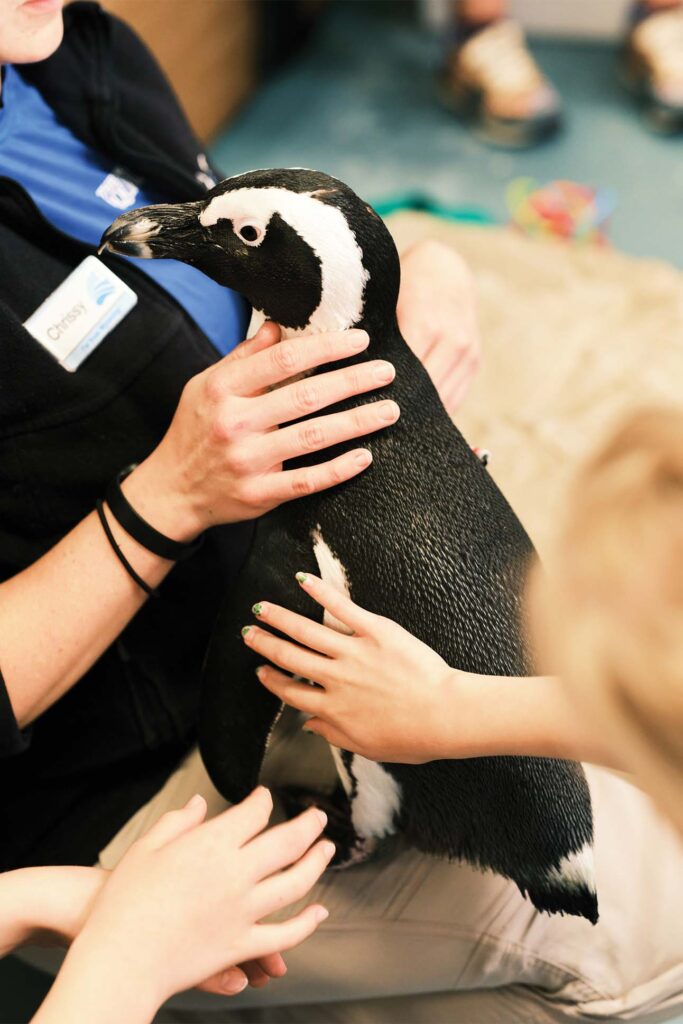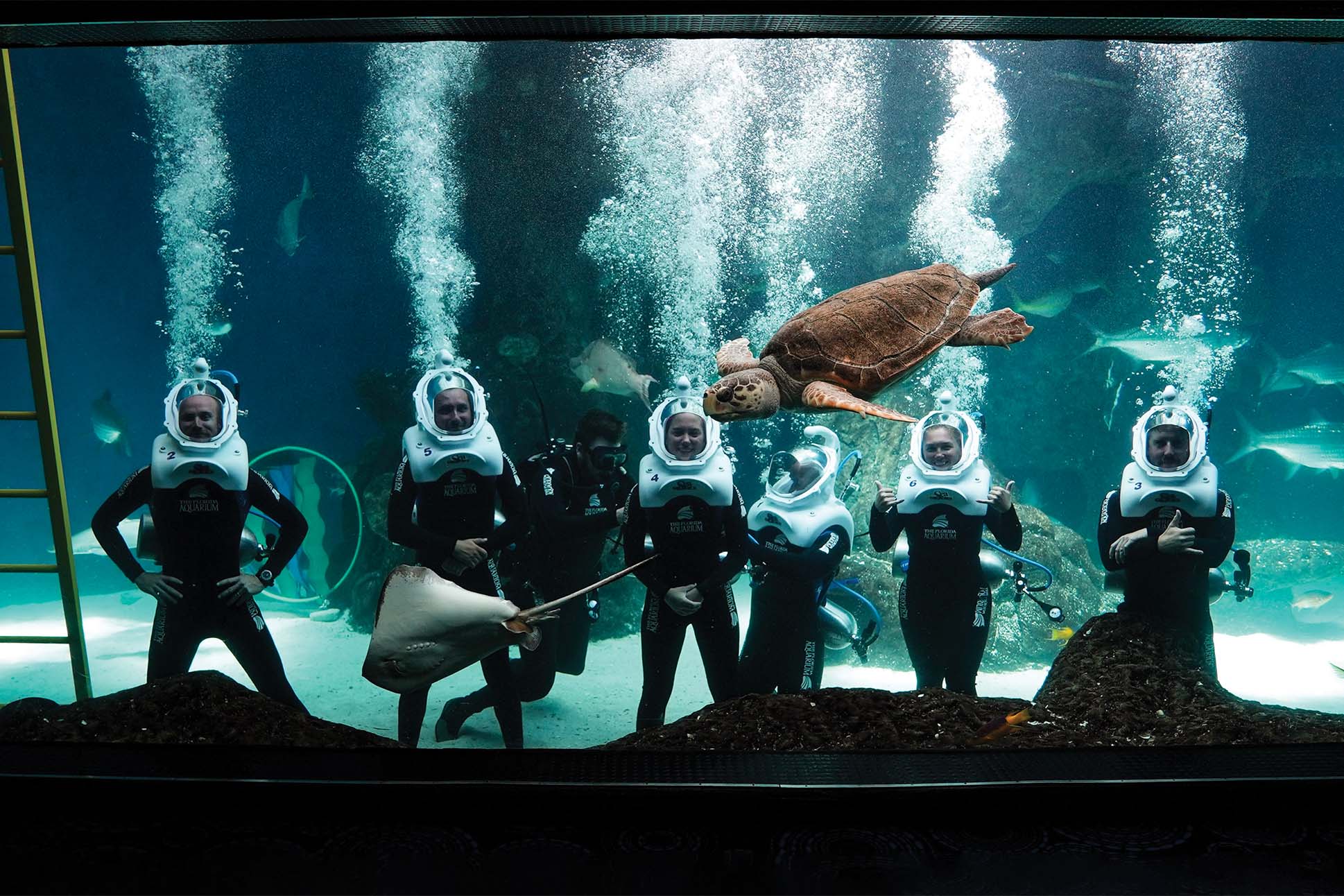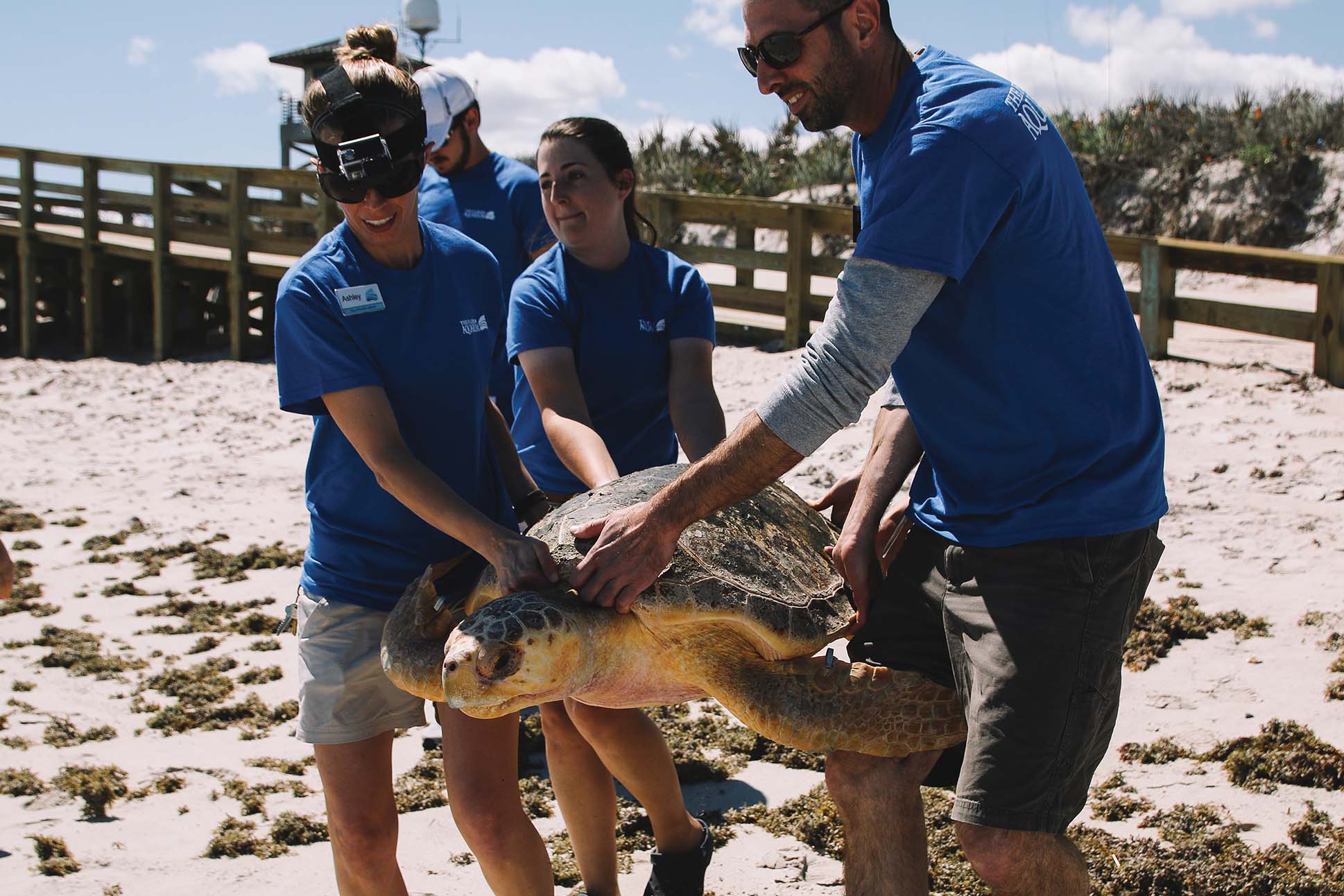By Ray Roa
Life’s not the same after a date with a South African black-footed penguin. For starters, their breath reeks of smelt and sardines. They stand just about two-feet tall, and bray like donkeys. But those beady eyes are hard to forget. And if one projectile poops on you, well, there’s apparently a t-shirt for that—at least at The Florida Aquarium.
“We’re going to take you to the gift shop after this,” Maegan Gentry told a lucky young visitor who got, well, blessed, during a recent penguin encounter.
Gentry, the aquarium’s Senior Penguin Biologist, recently spent almost an hour one afternoon introducing a small group of visitors to Nuru and Enzi, two of the nine penguins who call Florida Aquarium home. During the meet-and-greet, the birds waddle around the floor, pick up balls, hop on faux rocks, eat fish, and show off their training.
Along with a dolphin cruise and SeaTrek underwater excursion (stylized “SeaTREK”), the penguin encounter is one of three enhanced experiences Tampa’s 29-year-old nonprofit aquarium offers as extras.
After Nuru and Enzi pose for pictures with their guests, Gentry explains the duo accounts for just two of the approximately 10,000-13,000 penguins in breeding programs. Sadly, less than 44,000 are left in the wild.


Nuru and Enzi, South African black-footed penguins at The Florida Aquarium.
Only eight people get to take part in helping care for the penguins as part of this unique engagement, but all of them, from the kids to the parents, walk out of the room transformed.
Debbi Stone, Senior Vice President of Engagement and Learning at Florida Aquarium, knows how powerful those experiences—and even a simple conversation with one of the biologists—can be.
In her nearly 24 years at the facility, she’s seen it all, including shy kids coming out of their shells after hearing scientists talk about their jobs. Exposing guests to the possibility of a career in the field is paramount to the aquarium’s mission to not only deliver world-class care to its animals but also inspire action towards conserving species and habitats around the globe.
“It’s one of those things that’s hard to describe, but when you see it, you know it,” Stone says about the young visitors who go on to do great things in the field.
She’s seen firsthand how people move through the aquarium to bigger roles here at home and further away. Eighth grade campers regularly come back as college interns before moving on to work in conservation positions across the country. Stacianne Wiech, now Vice President of Education at Zoo Atlanta, got her start as the aquarium’s grant funded Homeschool Coordinator and Educator.

“It really does happen all the time,” Stone says. “That’s a really rewarding aspect of it.”
But it’s not just aspiring environmentalists who reap the benefits of engaging with the aquarium in more hands-on ways. Sometimes it’s people who didn’t even know they liked the water.
While the entire aquarium is immersive by nature, SeaTrek literally takes participants 15 feet underwater at the aquarium’s second-largest exhibit, Heart of the Sea. There, a guide walks them through the 100,000-gallon tank where they’re surrounded by fish, eagle rays, bonnethead sharks, and a loggerhead turtle named Shelldon. The best part is there’s no dive experience needed since the walk is made possible by a pressurized, oxygen-fed helmet that pretty much leaves hair dry.
Anyone at least 10 years-old can participate in SeaTrek, and after just a year-and-a-half since the experience’s launch, the aquarium has also been able to bring in more than 800 school kids from across the Bay area who otherwise might not have had the opportunity.
People just innately connect with animals.
Tony Rokita tells Current opening doors is a huge part of his job as The Florida Aquarium’s first-ever Senior Vice President of Community Engagement and Social Responsibility. The kids, he explains, not only see the underwater world, but get to be a part of it. Oftentimes, after leaving the tank, they want to fight for it.
“They think that it’s worth saving, they want to make sure it’s around,” Rokita, who for more than 30 years did similar community work for the Chicago Bulls, says.
“A lot of kids have gone from not knowing about that experience to becoming advocates, ambassadors, and kids that are talking about getting their own certification and becoming part of this entire aquarium world,” he adds. “It’s very cool.”
With more than 1 million people passing through the aquarium last year, not everyone gets to partake in supplemental experiences, but every inch of the exhibit pathways are designed with different guests in mind.


There’s much to see, do and explore at Florida Aquarium in Tampa, which hosts a million visitors a year.
“Social science shows us that every person comes in with their own value system, their own knowledge base, and their perceptions,” Stone notes.
So, the aquarium can’t just present content or information and expect guests to have an emotional connection. Instead, it deploys layered content visitors might not notice on the surface but absorb without thinking as they move through the 200,000 square-foot space—think touch tanks, videos, images, and staffers ready to engage with curious ticket holders.
“People just innately connect with animals. So, by doing a lot of different things, we have a much greater opportunity to connect with people, because there really is no one way,” Stone says.

She recently witnessed the aquarium’s philosophy in action inside the new, highly interactive “Morph’d” exhibit, which marks completion of the first of three phases in the aquarium’s $40 million expansion plan. The 3,700-square foot space showcases species with unique adaptations that help them survive in the wild.
One day, Stone saw what appeared to be a parent explaining the four-eyed fish display to their child.
“He was pointing, and saying, ‘So you see, what has happened there…,’ but he was actually just telling his son what he had just read on the wall about adaptation,” Stone says. “We’d spent so much time planning all this, and I’m actually watching this family encounter where he’s basically being the facilitator for his son who was really interested. It brought chills down my spine.”
Those are the kinds of moments that wait for everyone at The Florida Aquarium. While the center does offer experiences beyond what a guest gets with just a ticket, not everyone has to meet a penguin or walk through a giant fish tank to change their view. Sometimes, all they have to do is get their feet wet.


